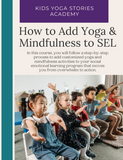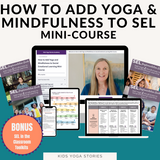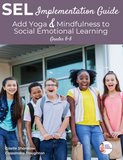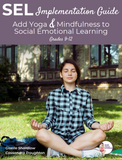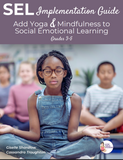How to Add Yoga and Mindfulness to (SEL) Social Emotional Learning Mini-Course
Bring calm, focus, and connection into your classroom with this step-by-step mini-course. In just 40 minutes, you’ll discover how to easily integrate yoga and mindfulness into SEL lessons—whether you’re starting from scratch or enhancing an existing program.
What’s Included:
✔️ 40 minutes of video lessons (4 bite-sized modules)
✔️ Interactive workbook with planning tools and examples (20 pages)
✔️ SEL Program Planner aligned with CASEL standards (50 pages for each!)
✔️ Comprehensive K–12 SEL Implementation Resources (K-2, 3-5, 6-8, 9-12)
-
Weekly implementation plans
-
Daily activity sample schedules
-
Detailed exercises by competency
-
✔️ Expert interviews for real-world insight
-
✔️ BONUS: 2- SEL in the Classroom Toolkits ($59.90 value!)
-
Preschool–2nd Grade: 4 weeks of daily yoga & mindfulness activities
-
3rd–5th Grade: 4 weeks of daily yoga & mindfulness activities
-
Themes include: Breathe Monday, Calm Tuesday, Connect Wednesday, Move Thursday, Play Friday

Perfect For:
-
Educators & counselors looking to create or enhance an SEL program
-
Kids yoga teachers wanting to show alignment with CASEL standards
-
Anyone seeking flexible, ready-to-use SEL activities
SKU:
Author:
Illustrator:
Page Count:
Binding:
Trim Size:
Edition:
Color:
Publication Date:








